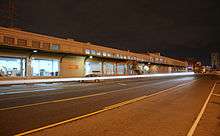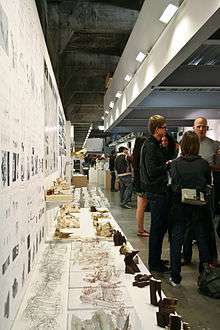Southern California Institute of Architecture
Southern California Institute of Architecture (SCI-Arc) is a private university focused on architecture and located in Los Angeles, California. Founded in 1972, SCI-Arc was initially regarded as—both institutionally and artistically—more avant-garde than traditional architecture schools based in the United States.[1] It consists of approximately 500 students and 80 faculty members, some of whom are practicing architects. It is based in the quarter-mile long (0.40 km) former Santa Fe Freight Depot in the Arts District in downtown Los Angeles, and offers community events such as outreach programs, free exhibitions, and public lectures.
| Type | Private |
|---|---|
| Established | 1972 |
| Director | Hernán Díaz Alonso |
| Students | 500 |
| Location | , , United States 34.045984°N 118.233431°W |
| Campus | Urban |
| Website | www.sciarc.edu |
History
SCI-Arc was founded in 1972 in Santa Monica by a group of faculty and students from Department of Architecture at California State Polytechnic University, Pomona, who wanted to approach the subject from a more experimental perspective than traditional schools offered.[2] Originally called the New School, SCI-Arc was based on the concept of a "college without walls" and it remains one of the few independent architecture schools in the world. Initially, instead of academic hierarchies the School favored a horizontal relationship between professors and students, who took responsibility for their own course of study. Ray Kappe, who had founded the Pomona department, became the new school's first director, served in that position until 1987, and was awarded the AIA/ACSA Topaz Medal for excellence in architecture education in 1990.[3]
Kappe was succeeded as director by Michael Rotondi, one of SCI-Arc's founding students. Neil Denari became director in 1997; Eric Owen Moss served as director from 2002–2015;[4] Hernán Díaz Alonso was appointed Director and Chief Executive Officer effective Sept 1, 2015.[5] Díaz Alonso has been a faculty member at SCI-Arc since 2001. He is known for championing the school's push toward a digital future and, prior to his appointment as Director, has served as the school's Graduate Programs Chair since 2010.[5] Although SCI-Arc was once unaccredited and its finances unstable—Moss joked, "We used to be considered one step ahead of the IRS, one step ahead of creditors"—the school is now fully accredited, and its finances improved to the point that SCI-Arc was able to pay $23.1 million to buy its campus building in 2011.[2] "The main thing is to figure out a way for SCI-Arc to keep growing without losing its character and pedigree," Díaz Alonso said in an interview following his appointment as Director.[5]
Downtown Los Angeles campus

The open nature of SCI-Arc's program is reflected in the series of industrial buildings that have housed the school, where students are encouraged to design and construct their own studio environments, and occasionally full-scale projects. The school has been based in three locations—the first (1972-1992) a small industrial building in Santa Monica and later moved into the second, a much larger (architecturally unique concrete post & beam) industrial building (1992-2000) in Marina del Rey. In 2001, it moved to its current home, the 60,000-square-foot 1907 Santa Fe Freight Depot designed by Harrison Albright on the eastern edge of Downtown Los Angeles. When SCI-Arc arrived, the building was a stripped-down concrete shell. Today the building is on the National Register of Historic Places and the school has become an anchor for the city's Arts District. The school conducts design projects that engage with under-served members of the community. To these ends, SCI-Arc has been awarded a $400,000 grant by ArtPlace to develop two on-campus public performance/lecture spaces, as well as development for a third public venue in the surrounding arts district.[6] Across the street, "One Santa Fe," a 438-unit apartment complex designed by Michael Maltzan Architecture (MMA) opened in 2014.[7]
School culture

SCI-Arc attracts students from nearby and throughout the world in pursuit of the educational programs that the school offers. Most students have already completed some college level work; some already hold professional architectural degrees. SCI-Arc is serious about educating and challenging its students—but does it so in an unconventional atmosphere. It is not uncommon to see a student using his or her skateboard to get from one end of the building to the other, or to be working on a model with his or her dog napping nearby. Students actively engage in preparing the SCI-Arc Gallery exhibitions, help fellow graduating students in setting up their models for thesis presentations, and contribute to workshops that result in projects throughout the school, such as the graduation pavilion and other unique structures. Students have access to their SCI-Arc studio spaces 24 hours a day, 7 days a week.[8]
Academics
SCI-Arc offers undergraduate and graduate degree programs accredited by the National Architectural Accrediting Board (NAAB) and the Western Association of Schools and Colleges (WASC), including a five-year Bachelor of Architecture (B.Arch) program, a 3-year Master of Architecture (M.Arch 1) open to applicants who hold a bachelor's degree or equivalent in any field of study, and a 2-year Master of Architecture (M.Arch 2) open to applicants with a prior undergraduate degree in architecture.
In the fall and spring terms, design studios, seminars and workshops led by SCI-Arc faculty and visiting instructors offer students a multitude of choices and perspectives. During the summer term, some courses are also open to upper-level students from other architecture programs and to the public. Summer at SCI-Arc features two intro to architecture programs open to the public: Design Immersion Days, a four-week intense design and architecture workshop for high school students, and MAKING+MEANING, a four-week foundation program in architecture that introduces the principles of architecture in a hands-on exploration of spatial experimentation, design methodologies and the creative process.
In addition to its undergraduate and graduate programs, SCI-Arc offers four one-year postgraduate programs in fields including architectural technologies, entertainment and fiction, design of cities, and theory and pedagogy.
SCI-Arc's undergraduate and graduate programs culminate in two public events in which students present their thesis projects to renowned critics from around the world, including Peter Cook, Greg Lynn, and Pritzker Prize recipient Thom Mayne.[9] "SCI-Arc has long been one of this country’s best experimental labs in which designers speculate about the future of the human-made environment, and its thesis projects are its calling cards."[10]
Public programs
SCI-Arc's public programs invite the community into the school to foster debate and understanding of architecture's capacity to transform the world. A recent program and exhibition, "LA in Wien/Wien in LA," investigated the architecture of Los Angeles and Vienna and their respective influences on one another in over the last century. It brought together six esteemed international architects—Hitoshi Abe, Peter Cook, Eric Owen Moss, Thom Mayne, Peter Noever, and Wolf Prix of Coop Himmelb(l)au—to share their perspectives and experiences in a discussion led by Anthony Vidler. The full scope of SCI-Arc public programs includes lectures, exhibitions, faculty talks and other opportunities for interaction between the school and the community.
Lecture series
Each semester's lecture series produces an eclectic selection of speakers from multiple disciplines, including architects, artists, film-makers, engineers, theoreticians, and performers. Speakers are selected by a forum of students, faculty, alumni, and administrators and the lectures are free and open to the public. Lectures are followed by a dinner in honor of the speaker, allowing students and faculty to interact more personally with the invited speaker. SCI-Arc lectures are broadcast for live viewing on the internet.
SCI-Arc Robot House
SCI-Arc's Robot House, initiated by faculty members Peter Testa and Devyn Weiser, builds upon the school's strengths to create a next generation platform for experimentation and speculation on the future of architecture.[11]
Situated conceptually and physically between studio and shop, academy and industry, the lab focuses on multi-robot cooperation and collaboration using six state-of-the-art Staübli robotic systems. The Robot House offers a new design interface extending beyond a production facility. It creates unprecedented emulation, simulation and animation environments in which computational geometry, material agency and fabrication logistics merge. The introduction of video, vision and sensing technologies with the lab's robotic systems support feedback and exchanges between matter, data and form.
Projects explore additive free-form fabrication tied to advanced composite materials. The robots themselves, relatively small in size and dexterity, support a reconfigurable 3D workspace with a wide range of applications including on-site construction.
References
- "Justin McGuirk, "The New LA School", October 2007". IconMagazine. Archived from the original on February 3, 2010.
- Vincent, Roger (April 22, 2011). "L.A. architecture school SCI-Arc buys its unorthodox home". Los Angeles Times. Retrieved April 23, 2011.
- Volume5. 25 Years of SCI-Arc 1990–1997 19 Sep 2007.
- Barrie-Anthony, Steven. Landscape of constant change. Los Angeles Times. July 7, 2005. Retrieved 15 January 2007.
- Gelt, Jessica (November 19, 2014). "SCI-Arc's newly announced director sees growth and a global presence". Los Angeles Times. ISSN 0458-3035. Retrieved 2015-09-28.
- Nielson, Christopher. "ArtPlace Announces 47 New Grants". artplaceamerica.org. Archived from the original on 15 June 2012. Retrieved 14 June 2012.
- Hawthorne, Christopher (October 10, 2014). "Maltzan's One Santa Fe apartment complex plays with notion of density". Los Angeles Times.
- "Learn About SCI-Arc and What It Takes to Get In". Retrieved 2015-09-28.
- Nielson, Christopher. "2011 Thesis & Graduation Weekend". Archived from the original on 19 January 2012. Retrieved 14 June 2012.
- "SCI-Arc Keeps Us Wondering". Retrieved 2015-09-28.
- "SCI-Arc students take 3D printing to the robots". www.gizmag.com. Retrieved 2015-09-28.
External links
| Wikimedia Commons has media related to Southern California Institute of Architecture. |